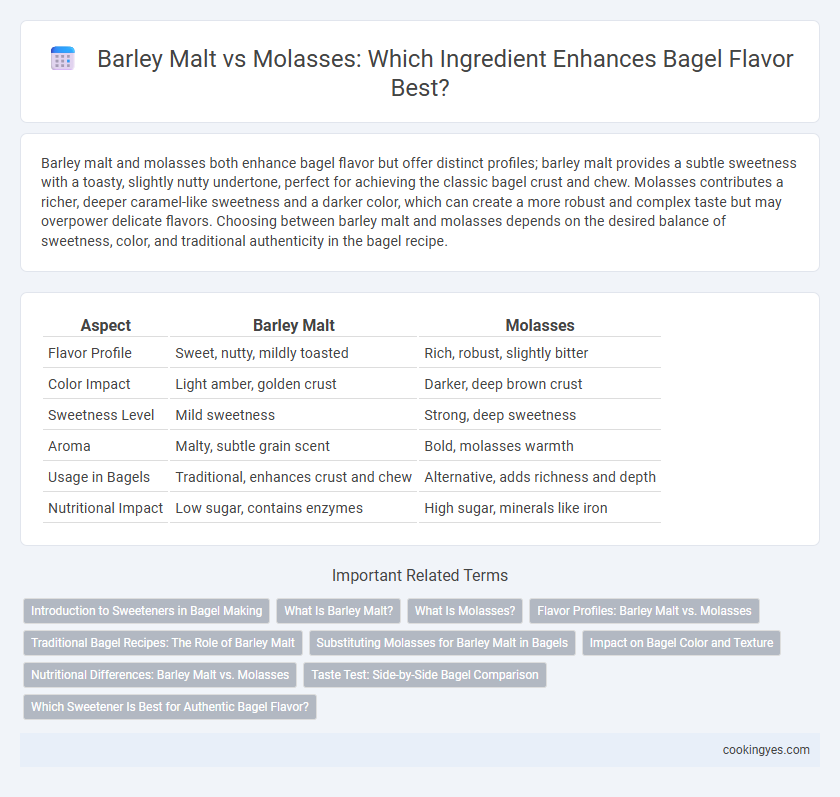Barley malt and molasses both enhance bagel flavor but offer distinct profiles; barley malt provides a subtle sweetness with a toasty, slightly nutty undertone, perfect for achieving the classic bagel crust and chew. Molasses contributes a richer, deeper caramel-like sweetness and a darker color, which can create a more robust and complex taste but may overpower delicate flavors. Choosing between barley malt and molasses depends on the desired balance of sweetness, color, and traditional authenticity in the bagel recipe.
Table of Comparison
| Aspect | Barley Malt | Molasses |
|---|---|---|
| Flavor Profile | Sweet, nutty, mildly toasted | Rich, robust, slightly bitter |
| Color Impact | Light amber, golden crust | Darker, deep brown crust |
| Sweetness Level | Mild sweetness | Strong, deep sweetness |
| Aroma | Malty, subtle grain scent | Bold, molasses warmth |
| Usage in Bagels | Traditional, enhances crust and chew | Alternative, adds richness and depth |
| Nutritional Impact | Low sugar, contains enzymes | High sugar, minerals like iron |
Introduction to Sweeteners in Bagel Making
Barley malt and molasses are key sweeteners that influence the distinct flavor and crust color of bagels. Barley malt, derived from sprouted barley grains, imparts a subtle, malty sweetness and enhances browning during baking, contributing to the traditional chewy texture. Molasses, a byproduct of sugar refining, offers a robust, richer sweetness with caramel notes but can produce a denser crumb and darker crust.
What Is Barley Malt?
Barley malt is a natural sweetener derived from malted barley grains, commonly used in bagel dough to enhance flavor and promote browning during baking. Unlike molasses, which has a robust, smoky sweetness, barley malt imparts a subtle, nutty taste and improves the bagel's crust texture. Its enzymes also aid in fermenting the dough, contributing to the characteristic chew and depth of flavor in traditional bagels.
What Is Molasses?
Molasses is a thick, dark syrup produced during the sugar extraction process from sugarcane or sugar beets, known for its rich, robust sweetness and slightly bitter undertone that enhances bagel flavor. Compared to barley malt, molasses imparts a deeper, caramelized taste with complex notes of smoky and earthy flavors, which can add warmth and depth to bagels. Its higher sugar content also contributes to faster crust browning and a chewier texture, making molasses a popular alternative for flavoring bagels.
Flavor Profiles: Barley Malt vs. Molasses
Barley malt imparts a subtle sweetness and a rich, malty depth to bagels, enhancing their traditional chewy texture and golden crust. Molasses offers a robust, slightly bitter sweetness with complex caramel and smoky notes, delivering a denser and darker crumb. Choosing barley malt emphasizes a classic bagel flavor, while molasses introduces a more intense and bold taste profile.
Traditional Bagel Recipes: The Role of Barley Malt
Traditional bagel recipes rely on barley malt to enhance flavor and texture, imparting a subtle sweetness and a rich, caramelized crust that molasses cannot replicate. Barley malt contains enzymes that help achieve the iconic chewiness and golden-brown color characteristic of authentic bagels. Molasses, while sweet, lacks the enzymatic properties essential for the traditional bagel's unique bite and glossy finish.
Substituting Molasses for Barley Malt in Bagels
Substituting molasses for barley malt in bagels enhances the dough with a richer, slightly sweeter flavor profile while maintaining the chewy texture characteristic of traditional bagels. Molasses provides a deeper, caramel-like sweetness and a darker color, which can intensify the crust's appearance and taste. Although molasses lacks the enzymatic properties of barley malt, its high sugar content supports yeast fermentation, ensuring proper rise and browning during baking.
Impact on Bagel Color and Texture
Barley malt contributes a rich, amber hue and a chewy texture to bagels, enhancing their traditional crust and softness. Molasses imparts a darker, more intense color with a slightly denser crumb, giving bagels a robust and sweet complexity. The choice between barley malt and molasses significantly influences the bagel's visual appeal and mouthfeel, with malt favoring a classic look and texture, while molasses offers deeper color and a heavier bite.
Nutritional Differences: Barley Malt vs. Molasses
Barley malt and molasses both enhance bagel flavor but differ significantly in nutritional content. Barley malt is lower in calories and sugars, providing enzymes that aid in dough fermentation and a subtle sweetness rich in maltose. Molasses contains higher iron, calcium, and potassium levels, offering greater mineral density but also increased sugar content, which impacts overall calorie count and sweetness intensity in bagels.
Taste Test: Side-by-Side Bagel Comparison
Barley malt imparts a subtle sweetness and enhances the traditional bagel crust's caramelized flavor, while molasses delivers a richer, deeper sweetness with slight bitterness. Taste tests reveal that barley malt produces a lighter, more authentic bagel taste favored by classic recipes, whereas molasses offers a robust, complex flavor profile that some find overpowering. Consumer preferences during side-by-side comparisons tend to lean towards barley malt for its balanced sweetness and aromatic depth in bagel crusts.
Which Sweetener Is Best for Authentic Bagel Flavor?
Barley malt provides a subtle, complex sweetness with a slightly nutty and toasted flavor, making it the preferred sweetener for authentic bagel flavor. Molasses imparts a stronger, more robust sweetness with a hint of bitterness that can overpower traditional bagel taste. Expert bakers favor barley malt syrup for its ability to enhance crust color and depth of flavor without masking the classic bagel profile.
Barley malt vs molasses for bagel flavor Infographic

 cookingyes.com
cookingyes.com